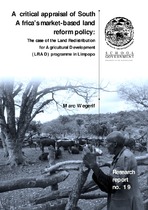| dc.contributor.author | Wegerif, Marc | |
| dc.date.accessioned | 2019-03-07T09:17:43Z | |
| dc.date.available | 2019-03-07T09:17:43Z | |
| dc.date.issued | 2004 | |
| dc.identifier.citation | Wegerif, M. (2004). A critical appraisal of South Africa’s market-based land reform policy: The case of the Land Redistribution for Agricultural Development (LRAD) programme in Limpopo. Research Report 19. Institute for Poverty, Land and Agrarian Studies, University of the Western Cape | en_US |
| dc.identifier.uri | http://hdl.handle.net/10566/4381 | |
| dc.description.abstract | In 1996 less than 1% of the population
owned and controlled over 80% of
farm land. This 1% was part of the
10.9% of the population classified as white
(Stats SA 2000). Meanwhile, the 76.7% of
the population that is classified as African
had access to less than 15% of agricultural
land, and even that access was without
clear ownership or legally-recognised
rights. An estimated 5.3 million black
South Africans lived with almost no tenure
security on commercial farms owned by
white farmers (Wildschut & Hulbert 1998).
The legacy of apartheid was not just the
inequality in access to resources such as
land, but a faltering economy that by 1994
had been through two years of negative
growth and left the majority of the
population in poverty (Sparks 2003). | en_US |
| dc.language.iso | en | en_US |
| dc.publisher | Institute for Poverty, Land and Agrarian Studies, University of the Western Cape | en_US |
| dc.relation.ispartofseries | Research Report;19 | |
| dc.subject | South Africa | en_US |
| dc.subject | Land reform policy | en_US |
| dc.subject | Colonisation | en_US |
| dc.subject | Apartheid | en_US |
| dc.subject | Land reform | en_US |
| dc.title | A critical appraisal of South Africa’s market-based land reform policy: The case of the Land Redistribution for Agricultural Development (LRAD) programme in Limpopo | en_US |
| dc.type | Other | en_US |

